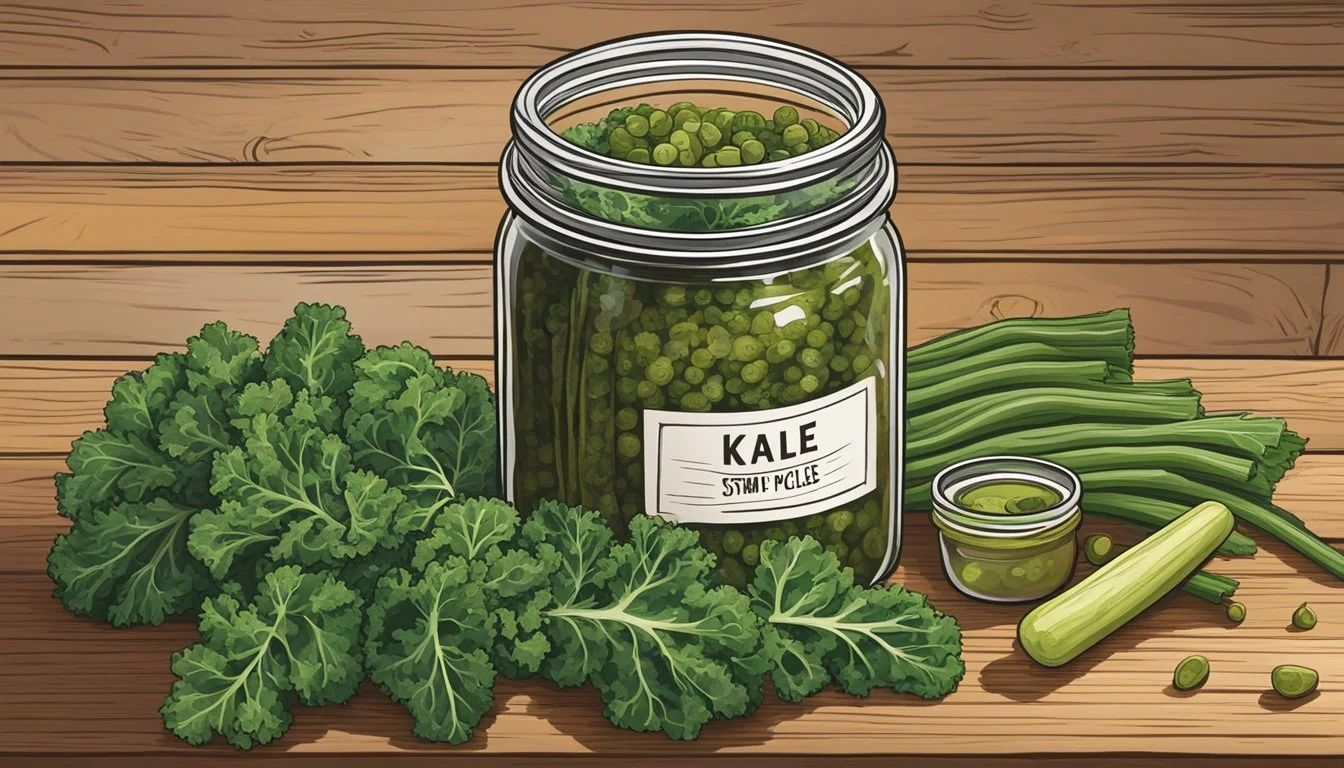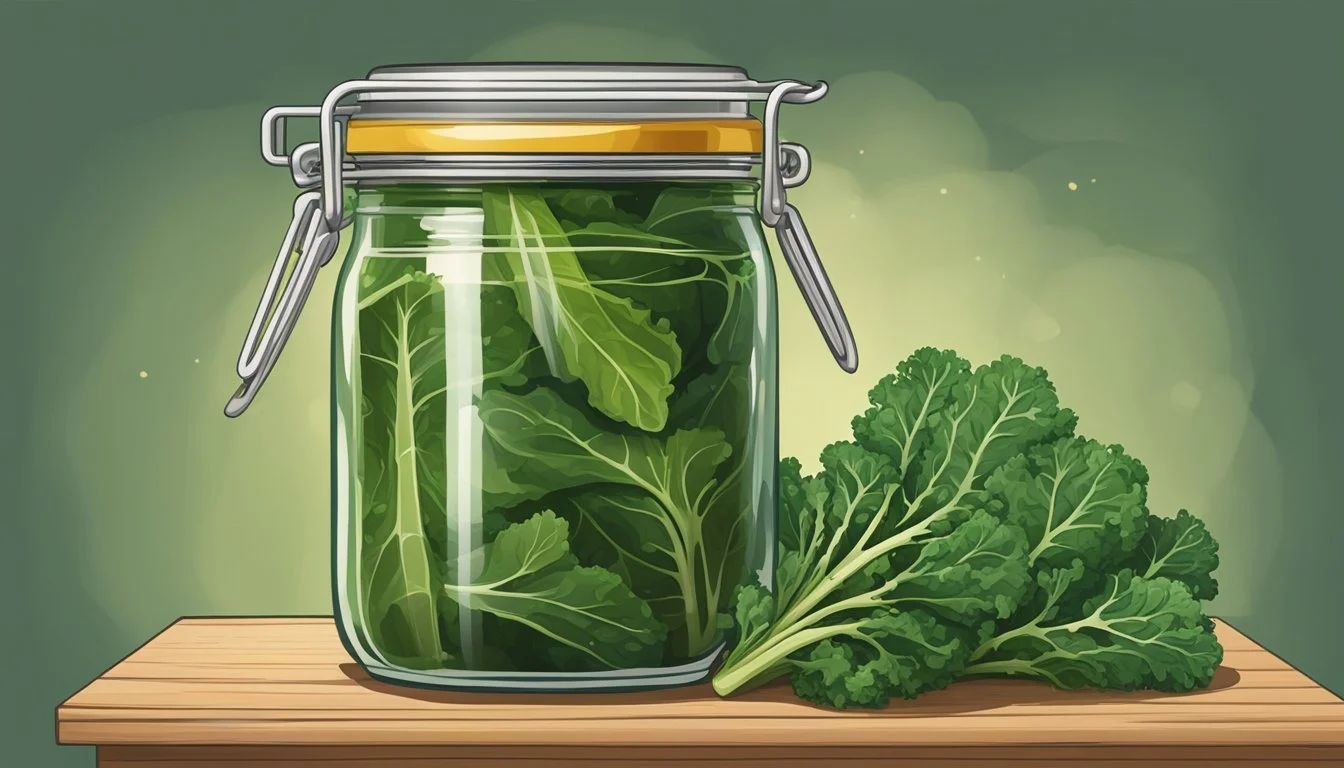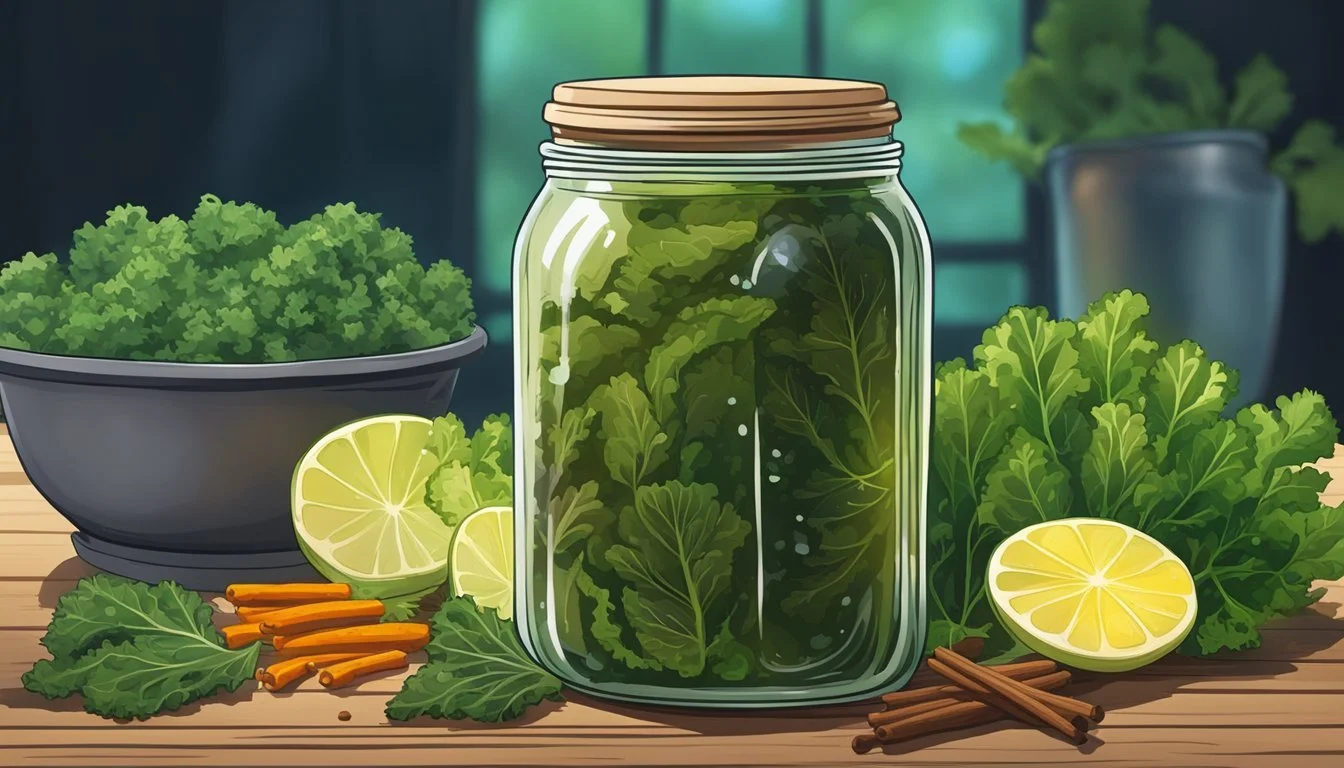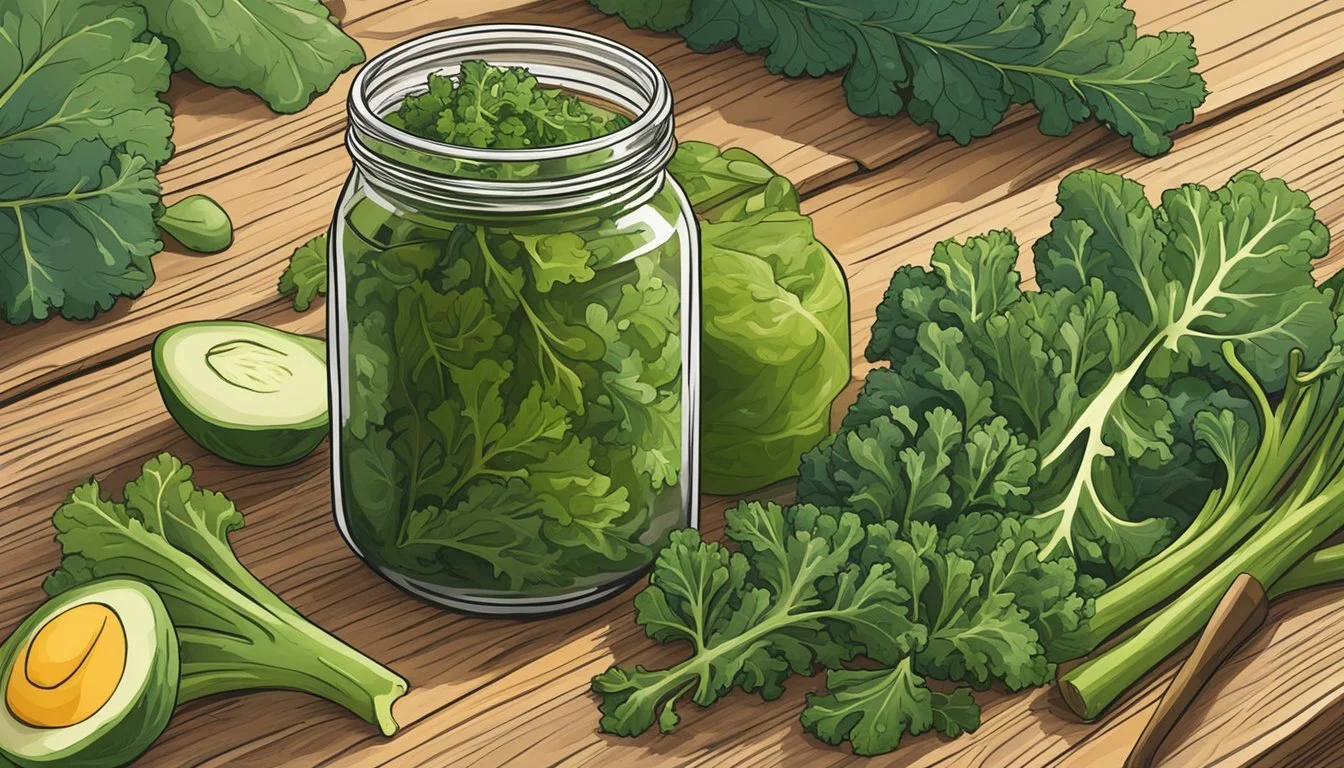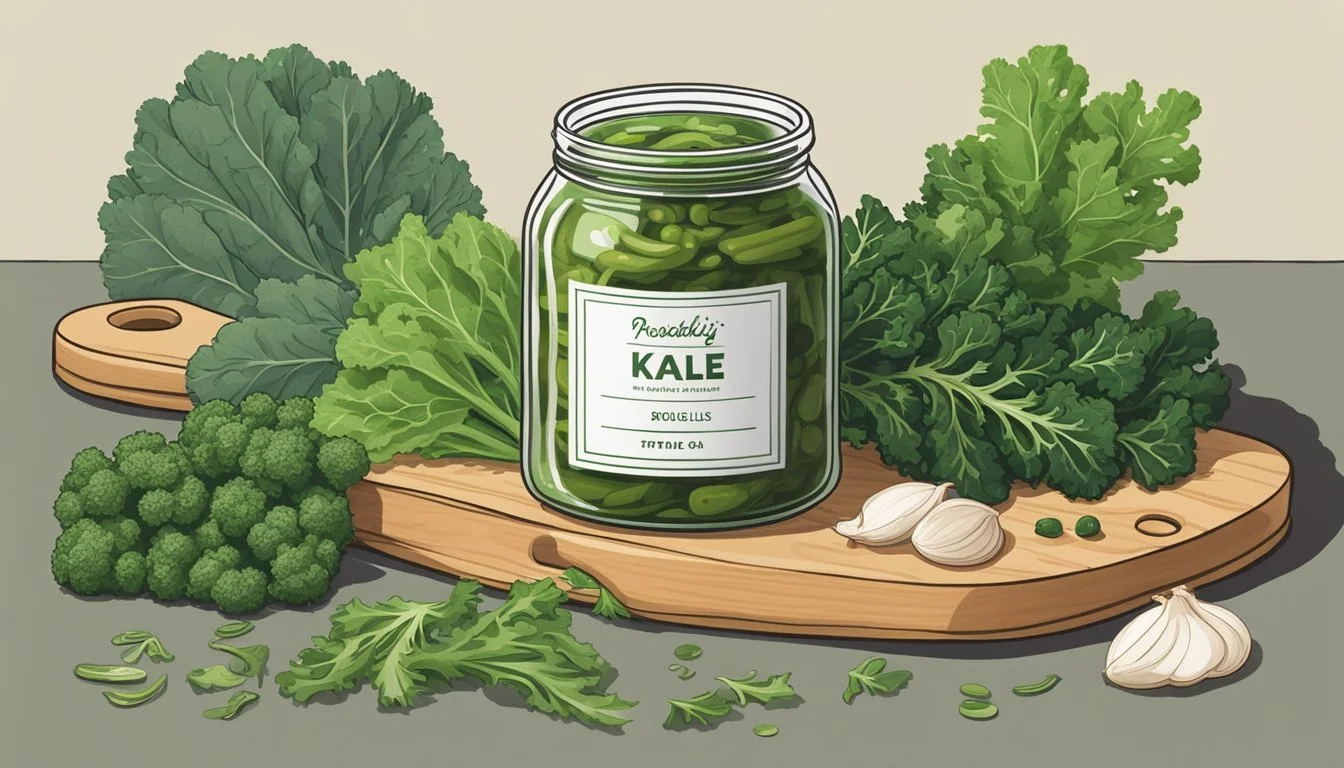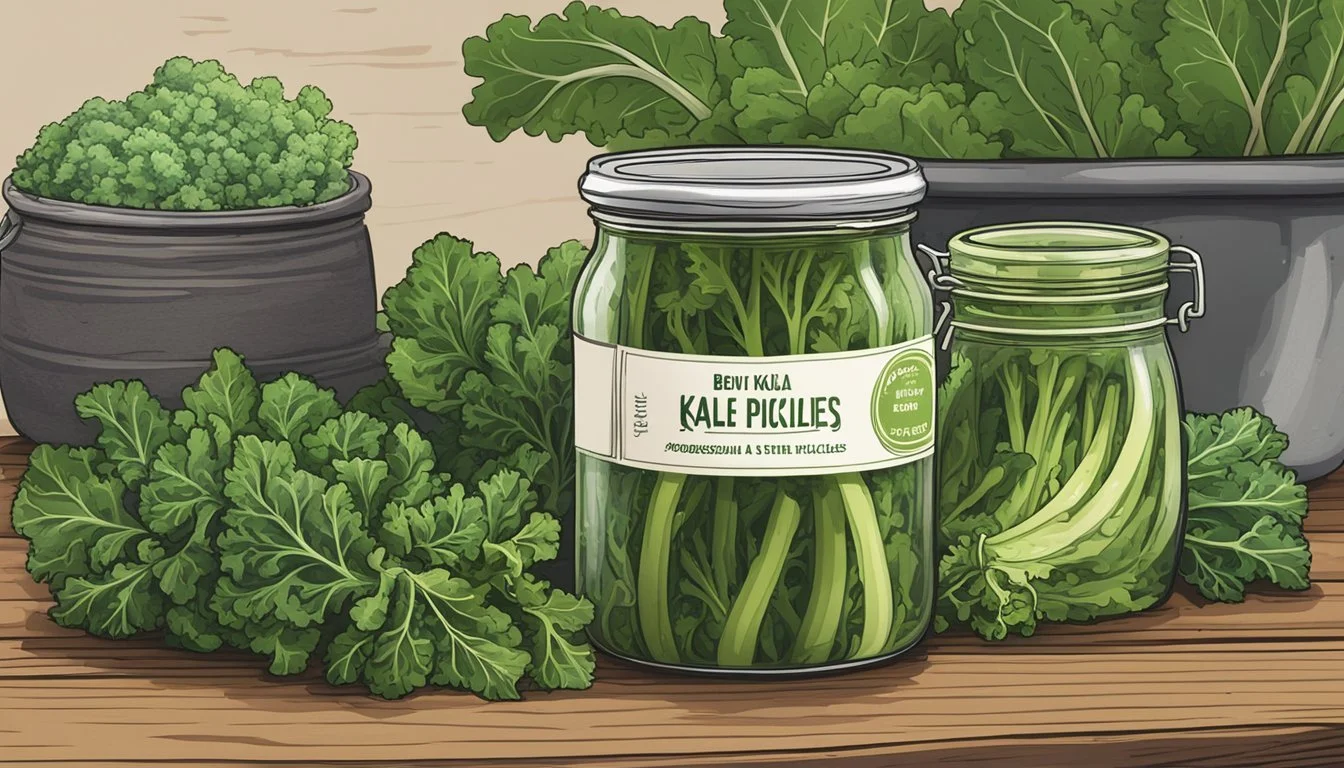Kale Stem Pickles
A Tangy, Probiotic-Rich Snack Unveiled
Kale stem pickles transform what is often discarded into a tangy treat that pairs well with a multitude of dishes. Kale, a leafy green recognized for its high nutritional value, typically sees its leaves consumed while the stems are thrown away due to their tough texture. However, pickling these stems not only reduces food waste but also yields a flavorful, crisp, and healthful addition to any snack or meal time. The process of pickling can imbue the stems with a variety of flavors, from garlic and peppercorns to sweeter notes with sugar or even the subtle tang of vinegar.
These pickled creations are not just a clever use of leftovers; they are teeming with probiotics, the beneficial bacteria that support gut health. During the pickling process, the naturally occurring lactobacillus bacteria on the surface of the kale stems can flourish, turning the brine into a probiotic-rich liquid. As a result, kale stem pickles offer a unique combination: the fibrous benefits of kale and the gut-health properties of fermented foods. (What wine goes well with fermented foods?)
Embracing kale stem pickles is an ideal way to introduce a probiotic element into daily eating habits without compromising on taste. By integrating these pickled stems into salads, sandwiches, or serving as a stand-alone side, individuals can enjoy a crunchy and nutritious snack that enhances the body's probiotic intake. This method of repurposing kale stems not only highlights the versatility of the ingredient but also invites an adventurous approach to sustainable cooking and consumption.
Understanding Fermentation
Fermentation is a biological process that transforms food through the action of beneficial bacteria, enhancing both its nutritional value and longevity. This section explores the fundamental concepts, health implications, and historical importance of fermentation in foods such as kale stem pickles.
Basics of Fermentation
Fermentation involves the metabolic process where microorganisms like bacteria, yeasts, or fungi convert organic compounds, typically sugars and starches, into alcohol or acids. With respect to vegetables like kale stems, lactic acid bacteria such as Lactobacillus dominate the fermentation process. These bacteria are responsible for the sour taste of fermented foods and act as natural preservatives.
Primary Components: sugars, bacteria (often lactobacillus), and a brine or anaerobic environment
Key Outputs: lactic acid, carbon dioxide, and sometimes ethanol
Fermentation and Gut Health
The fermentation process cultivates live cultures and probiotics, which are live bacteria that provide health benefits when consumed. These probiotics, especially found in fermented foods, play a vital role in maintaining a healthy gut microbiome by assisting digestion and bolstering the immune system. The gut microbiome is a complex community of microorganisms living in the digestive tracts, and a balanced microbiome is crucial for optimal digestion and overall health.
Health Benefits:
Supports a balanced gut microbiome
Aids in digestion and nutrient absorption
Potentially strengthens the immune system
Fermented Foods and Historical Significance
Fermented foods have been a staple in human diets for thousands of years. Sauerkraut in Europe and kimchi in Korea are two prominent examples of culturally significant fermented foods. The preservation aspect of fermentation allowed our ancestors to store food for longer periods without refrigeration, while the enhanced flavors and nutritional benefits played vital roles in their diets.
Historical Role:
Preservation of food before modern storage methods
Introduction of complex flavors and textures in traditional diets
Contribution to cultural culinary practices
Fermentation remains an integral part of global food traditions, and contemporary interest in probiotic-rich foods like kale stem pickles reflects a resurgence in recognizing the value of this ancient practice.
Nutritional Profile of Kale Stem Pickles
Kale stem pickles are more than just a means to reduce food waste. They encapsulate a wealth of nutrients and provide probiotic benefits that support gut health, making them a powerhouse for nutrition.
Vitamins and Minerals in Kale Stems
Kale stems are a robust source of essential vitamins and minerals. Notably, kale is known for its high content of Vitamin K, which is crucial for blood clotting and bone health. It also contains Vitamin C, an antioxidant that supports the immune system, and Vitamin A, important for vision and skin health. Here is a breakdown of the key vitamins and minerals found in kale stems:
Vitamin K: Critical for bone health and wound healing
Vitamin C: Supports immune function and skin health
Vitamin A: Vital for eye health and immune function
Calcium: Essential for bone strength and dental health
Potassium: Regulates fluid balance and blood pressure
Fiber: Enhances digestive health
Probiotic Benefits of Kale Stem Pickles
When kale stems are pickled, they undergo fermentation, a process that adds probiotic properties to the snack. Probiotics are beneficial bacteria that support gut health and digestion. They've been linked to a variety of health benefits, including improved digestion, enhanced immune function, and reduced inflammation. The presence of these live cultures in kale stem pickles can contribute to a balanced gut microbiome.
In terms of gut health, pickled kale stems offer both fiber and probiotics, which support the growth of healthy gut bacteria and promote a healthy digestive system. Regular consumption of kale stem pickles could be an excellent way to enjoy the nutritional benefits of kale while also taking advantage of the probiotic benefits from the pickling process.
The Pickling Process
The pickling process involves preparing kale stems, creating a pickling brine, and understanding the roles of each ingredient. Spices add flavor, while the fermentation process ensures the stems are preserved and enriched with probiotics.
Preparing Kale Stems for Pickling
Kale stems should be thoroughly washed and then cut into uniform pieces, typically around 2 inches in length. Blanched in boiling water for crisp tenderness, the stems are then shocked in ice water to halt the cooking process. This step is crucial for maintaining texture.
Creating the Pickling Brine
The brine is a mixture of water, vinegar, and sometimes sugar, heated and stirred until the dry ingredients dissolve. The ratio of vinegar to water can vary, but a common mixture is equal parts of each. The brine's acidic environment is essential for preservation.
The Role of Salt, Sugar, and Vinegar
Salt: Essential for flavor and preservation, pickling salt is preferred due to its purity.
Sugar: While optional, it can balance acidity and add complexity to the flavor.
Vinegar: The acidic base of the brine, vinegar halts harmful bacterial growth, allowing the fermentation process to occur safely.
Seasoning with Spices
A variety of spices can be added to the kale stems for flavor:
Garlic: Adds significant aroma and taste.
Dill: Imparts a classic tangy pickling note.
Peppercorns: Introduce a warm, piquant flavor.
Spices are chosen based on desired flavor profiles and are typically added directly to the jar before the brine is poured over the kale stems.
Fermentation Process Details
Lacto-fermentation is a method where natural bacteria feed on sugar and starch in the food creating lactic acid. This process:
Preserves the stems
Enhances the nutrient content
Allows the development of probiotics
The fermentation time can vary, but typically a period of one to two weeks is sufficient for the kale stems to become tangy and probiotic-rich.
Recipe for Kale Stem Pickles
Transforming kale stems into a tangy, probiotic-rich snack is simple with this recipe for kale stem pickles. This section offers step-by-step instructions, important equipment selections, and ideas for flavor variations to create a unique and delicious pickle.
Step-by-Step Instructions
Ingredients:
2½ ounces kale stems, cut into 2-inch pieces
2 cups water, for blanching
1 teaspoon salt
1 cup vinegar (apple cider or white)
Optional flavorings: 12 peppercorns, 1 garlic clove, ½ teaspoon mustard seeds, ½ teaspoon dill seed
Prepare the kale stems: Start by washing the kale stems thoroughly to remove any dirt. Trim the ends and cut the stems into 2-inch pieces.
Blanch the stems: Bring 2 cups of water to a boil in a saucepan. Add the kale stems and blanch for 2 minutes until crisp-tender. Drain and immediately shock them in ice water to stop the cooking process.
Jar the stems: Once cool, drain the stems again. Place the stems in a clean 8-ounce heatproof mason jar, adding in the optional peppercorns, garlic, mustard seeds, and dill seed for additional flavor.
Create the brine: Combine vinegar, 1 cup water, and salt in a pot and bring to a boil.
Pour the brine: Carefully pour the hot brine over the kale stems in the jar, ensuring that they are completely submerged.
Seal and store: Close the jar with an airtight lid. Let it cool to room temperature before refrigerating. The pickles will develop flavor over time, tasting best after several days.
Choosing the Right Equipment
To pickle kale stems successfully, the right equipment is essential.
Heatproof jars: Mason jars are ideal for pickling because they can withstand hot brine without cracking and provide an airtight seal. Use jars that are free from cracks or chips to ensure safe preservation.
Saucepan: A medium-sized saucepan is needed to blanch the stems and to prepare the brine.
Tongs/Jar lifter: These are useful for handling hot jars and ingredients safely.
Cutting board and knife: These will be used for trimming and cutting the kale stems.
Ensure all equipment is clean and sterilized before use to prevent contamination.
Flavor Variations
The basic kale stem pickle recipe is a great canvas for flavor experimentation. To create a unique flavor profile, consider adding different combinations of spices and herbs.
Classic Dill: Add dill seed, fresh dill fronds, and garlic for a traditional dill pickle flavor.
Spicy: Introduce red pepper flakes or sliced jalapeños for a kick.
Sweet and Tangy: Incorporate a small amount of sugar and extra mustard seeds for a sweet, yet tangy variation.
Earthy: Add a pinch of cumin or coriander for an earthy twist.
One can adjust these flavorings to taste, remembering that the flavors will intensify over time as the pickles ferment.
Health Benefits and Risks
Kale stem pickles offer a unique blend of probiotics and nutrients that can be beneficial for gut health and immunity, while also presenting certain risks that consumers should be aware of.
Digestive and Immune Support
Probiotic-rich: Kale stem pickles are fermented foods, making them a rich source of probiotics which support gut health. They help in maintaining a healthy balance of gut bacteria, which is crucial for digestion and nutrient absorption.
Immune System: A well-functioning digestive system, bolstered by probiotics, supports the immune system. The gut is often referred to as the body's second brain and plays a key role in fending off pathogens.
Anti-inflammatory: Fermented kale stems contain anti-inflammatory properties which might reduce inflammation, potentially lowering the risk of chronic diseases.
Nutrients: They are typically high in essential vitamins and minerals, contributing to overall health and wellbeing.
Vitamin C: An antioxidant that plays a role in immune function.
Vitamin A: Important for vision and the immune system.
B-vitamins: Including vitamin B6, fundamental for energy metabolism and mental health.
Potential Risks and Considerations
While beneficial, kale stem pickles should be consumed in moderation due to various considerations:
Salt Content: Pickles are often high in sodium, which can lead to increased blood pressure, or hypertension, if consumed in large quantities.
Bloating and Constipation: For individuals sensitive to fermented foods, kale stem pickles could contribute to bloating or constipation due to their high fiber content.
It's important for individuals to consider their own health and dietary restrictions when incorporating kale stem pickles into their diet.
Incorporating Kale Stem Pickles into Your Diet
Kale stem pickles offer a zestful addition to meals, doubling as both a health food and a low-calorie snack. They deliver probiotic benefits and can easily elevate the taste profile of various dishes.
Serving Suggestions
Kale stem pickles can be enjoyed straight from the jar as a tangy snack or chopped finely to add a crisp, acidic note to salads. They also serve as a refreshing side or garnish, bringing a bright contrast to rich, savory flavors.
Salads: Toss chopped kale stem pickles into green, grain, or pasta salads for an unexpected crunch.
Snacks: Incorporate them into a cheese or charcuterie board for a probiotic-rich, health-conscious option.
Pairing with Other Foods
The versatility of kale stem pickles makes them an excellent pairing with a variety of foods. Their tangy flavor pairs well with the creamy textures of sandwiches and can be used to cut through the fattiness of meats.
Sandwiches: Layer them in sandwiches or wraps to add a probiotic punch.
Salads: Enhance salad dressings with finely chopped pickled stems for an additional layer of flavor.
Health Foods: For those mindful of their diet, kale stem pickles are a favorable add-on, enriching meals with their low-calorie profile without compromising taste.
Preservation and Storage
Preserving kale stem pickles properly extends their shelf life and maintains their quality. Proper storage methods prevent spoilage and ensure the pickles remain safe and flavorful for consumption.
Extending Shelf Life
To maximize the shelf life of kale stem pickles, one needs to sterilize jars or containers before use. Sterilization can be done by boiling the jars in water for ten minutes or using a dishwasher with a sterilization setting. After pickling, ensure the kale stems are completely submerged in the brine to prevent exposure to air which can lead to spoilage. The ideal storage temperature for unopened pickles is in a cool, dark place below 75°F (24°C). Once opened, refrigerating the pickles is crucial, ideally at temperatures between 34°F to 38°F (1°C to 3°C).
Checklist for Extending Shelf Life:
Sterilize storage containers
Submerge kale stems in brine
Store unopened containers in a cool, dark place
Refrigerate after opening
Understanding the Signs of Spoilage
Recognizing signs of spoilage in pickles is important for food safety. Kale stem pickles may spoil if the brine becomes cloudy, if there is mold growth, or if the pickles emit a foul odor. Containers that bulge or leak also indicate possible contamination. If the pickles have lost their characteristic tang or if there is a notable change in texture or color, it is best to discard them.
Signs of Spoilage:
Cloudy brine
Mold growth
Foul odor
Bulging or leaking containers
Changes in texture, color, or flavor
It's essential to monitor your pickles regularly for these signs to ensure they remain a safe and enjoyable snack.
Tips and Tricks for Perfect Pickles
Making the perfect kale stem pickles involves precision and a mindful approach to the pickling process. It's essential to maintain the correct salt-to-water ratio for the brine and to use techniques that ensure the crispness of the pickles to enjoy a crunchy, tangy snack that's also rich in probiotics.
Mastering the Salt-to-Water Ratio
For successful pickling, one must precisely balance the salt-to-water ratio in the brine. Too much salt can inhibit fermentation, while too little may lead to mold. Typically, for kale stem pickles, a ratio of 2 tablespoons of non-iodized salt to 4 cups of water is recommended. This ensures an environment conducive to fermentation, where beneficial bacteria can thrive, leading to the production of bubbles signaling a healthy fermentation process.
Key Salt-to-Water Ratio:
Ingredients Quantity Water 4 cups (32 ounces) Salt 2 tablespoons
Remember to use non-iodized salt, as iodine can impede fermentation and affect the flavor.
Ensuring Crispness
Crispness is a hallmark of an excellent pickle. To achieve this, one can blanch the kale stems in boiling water for about 2 minutes and then shock them in ice water to stop the cooking process. This technique firms up the cell walls, contributing to a crunchy texture. Additionally, using fresh, firm kale stems rather than older, more pliable ones is crucial, as this impacts the final texture of the pickles.
Steps to Ensure Crispness:
Blanch kale stems for 2 minutes.
Shock in ice water immediately afterward.
Drain well before pickling.
The equipment one uses is also a factor; opt for airtight jars or containers to store the pickles, as this preserves their texture and taste.
When handling the equipment, whether it's the kit for blanching or the containers for fermentation, ensure cleanliness to prevent the introduction of unwanted bacteria, which can lead to mold and spoilage. Proper sanitation is key for safe, delicious pickles.
Beyond Kale Stem Pickles
Exploring the world of fermented vegetables extends far beyond kale stems, revealing a wide array of flavors and health benefits.
Exploring Other Fermented Vegetables
Fermented vegetables are not limited to pickled kale stems. Carrots and beets are exemplary candidates for fermentation, each bringing their unique taste profiles to the table. Carrots, with their natural sweetness, can be transformed into crunchy lacto-fermented snacks that still retain a hint of earthy sweetness after fermentation. Beets, on the other hand, offer a deep, rich flavor and vibrant color that can enhance the visual and taste appeal of any fermented vegetable medley.
To ferment these vegetables, the process typically involves submerging them in a brine solution that encourages the growth of beneficial bacteria. This process is known as lacto-fermentation because the type of bacteria that thrives in this environment, Lactobacillus, is a natural lactic acid producer. This acid acts as a preservative, giving lacto-fermented pickles their characteristic tangy taste and increasing their shelf life.
Benefits of a Varied Fermented Diet
A diet that includes a variety of fermented vegetables enriches the gut with a diverse population of probiotics. Fermented vegetables are a natural source of these beneficial bacteria, contributing to an improved gut microbiome. Here are a few specific benefits:
Vitamins and Minerals: Fermented vegetables retain, and sometimes even amplify, their content of vitamins and minerals such as Vitamin K, Vitamin C, and potassium.
Improved Digestion: The probiotics present in fermented vegetables like fermented pickles can aid digestion and help maintain gut health.
Enhanced Bioavailability: The fermentation process can increase the bioavailability of nutrients, making them more accessible for the body to absorb.
It's important to note that not all pickled vegetables (What wine goes well with pickled vegetables?) are fermented. Regular pickles may be preserved using vinegar and heat, a process that does not foster the growth of probiotics. In contrast, fermented pickles are preserved through the natural fermentation process and are rich in probiotics. Consumers looking for these benefits should check labels for terms like "raw", "fermented", or "probiotics" to ensure they are getting the healthful attributes they desire.
Conclusion
Kale stem pickles serve as a testament to the ingenuity of culinary preservation, transforming a typically discarded ingredient into a tangy treat. Fermentation, a time-honored method, not only enhances the stems' flavor but also imbues them with probiotics, beneficial for gut health.
These pickles offer a unique flavor profile—a balance between crisp bitterness and savory tang—making them a versatile addition to many dishes. They also embody sustainability, as this approach reduces food waste by repurposing kale stems.
The health benefits of kale are well-documented, and its stems are particularly rich in nutrients like vitamin K and C, calcium, and iron. Pickling kale stems preserves these vitamins and minerals, whilst the fermentation process may increase bioavailability.
In creating Kale Stem Pickles, one receives not only a probiotic-rich snack but also contributes to ethical eating by minimizing waste. Their distinctive taste and health properties offer a nutritious alternative to traditional snacks.

